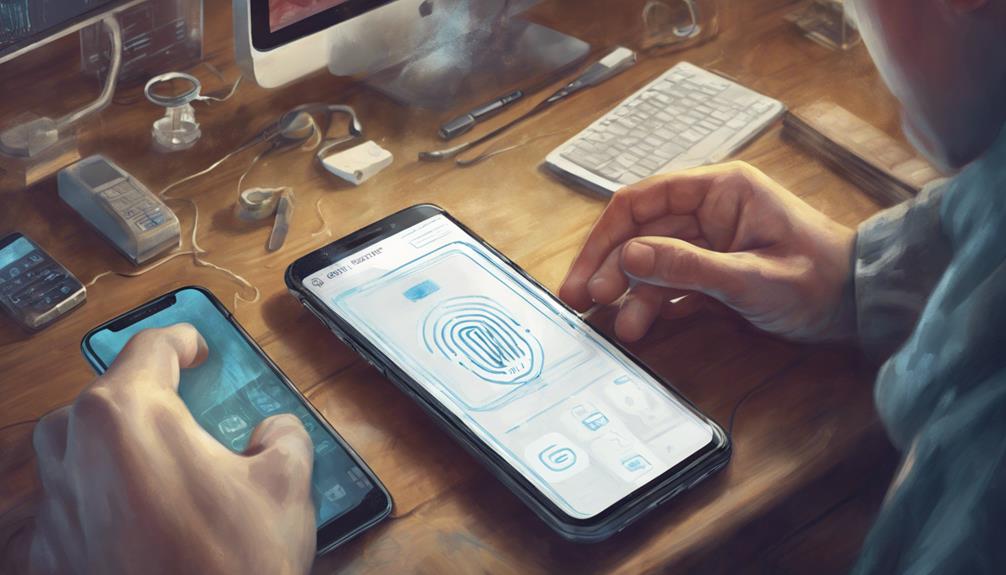Airplane mode is not a foolproof defense against hackers. It shuts off wireless communications but can still connect to Wi-Fi networks, leaving vulnerabilities. Hackers exploit these weak points, especially through active Bluetooth in airplane mode. For robust security, rely on additional protective measures beyond airplane mode. Vigilance is essential due to risks posed by open wireless connections. Sensitive data on devices remains at risk despite airplane mode. Implementing encryption, strong authentication, VPNs, and firewalls is recommended for enhanced security. Take proactive steps to safeguard against hacking attempts effectively.
Key Takeaways
- Airplane mode may not fully protect from hackers due to active Bluetooth and Wi-Fi.
- Vulnerabilities in wireless connections can still be exploited despite airplane mode.
- Additional security measures like encryption and strong authentication are essential.
- Understand limitations of airplane mode and implement proactive security steps.
- Disabling auto-connect settings and keeping devices secure are crucial for protection.
Airplane Mode Security Overview
In examining the security implications of airplane mode, it becomes evident that simply activating this setting does not guarantee protection against potential cyber threats. While airplane mode disables wireless transmissions, it may still allow connection to Wi-Fi networks, potentially exposing devices to hacking risks.
Hackers can exploit vulnerabilities in Wi-Fi connections even when a device is in airplane mode, leading to unauthorized access to sensitive data. Additionally, Bluetooth functionality can remain active in airplane mode, further increasing the risk of intrusion and unauthorized access to devices.
It is important to recognize that being connected to external networks via Wi-Fi while in airplane mode can compromise security, highlighting the significance of implementing additional security measures beyond relying solely on airplane mode.
Although airplane mode provides a basic layer of protection against certain hacking attempts, it is essential to understand its limitations and the need for a holistic approach to safeguarding devices from various cyber threats.
Wireless Communication Risks

When utilizing airplane mode, it's crucial to take into account the risks associated with wireless communication. Signal interception vulnerabilities and data privacy concerns are key points to be mindful of.
Despite the limitations on cellular transmissions, potential security threats can still exist through Wi-Fi and Bluetooth connections.
Signal Interception Vulnerabilities
Devices in airplane mode are susceptible to signal interception vulnerabilities, posing risks to wireless communications. Hackers can exploit these vulnerabilities to intercept data transmitted over Wi-Fi connections, potentially compromising sensitive information.
Despite being in airplane mode, Bluetooth functionality may still be active, creating a security risk for unauthorized access by malicious actors. This loophole could lead to unauthorized intrusion and data breaches if devices are connected to unsecured Wi-Fi networks.
To mitigate these risks, it is essential to implement additional security measures when using airplane mode. Ensuring that all wireless connections are encrypted and avoiding connecting to unknown or unsecured networks can help enhance the security of devices even when in airplane mode.
Staying vigilant and proactive in safeguarding wireless communications is vital to protect against signal interception vulnerabilities and potential exploitation by hackers.
Data Privacy Concerns
Highlighting the potential vulnerabilities arising from signal interception risks, the discussion now shifts towards the critical aspect of data privacy concerns related to wireless communication risks.
When a device is in airplane mode, cellular signals are disabled; however, Wi-Fi and Bluetooth connections may still be active, leaving potential privacy risks. Hackers can exploit these connections to eavesdrop on Wi-Fi signals or surveil through Bluetooth, compromising sensitive data.
To mitigate these risks, additional security measures are essential. Disabling Wi-Fi and Bluetooth when not in use and implementing robust authentication methods can greatly enhance data privacy in airplane mode.
It is essential for users to remain vigilant and proactive in safeguarding their information, especially in environments where hackers may attempt to breach data privacy.
Potential Data Breaches

Airplane mode may not completely protect devices from potential data breaches, as hackers can exploit vulnerabilities even when the mode is enabled.
Sensitive information stored on a device can still be at risk, especially if the device is physically accessed.
It is essential to implement additional security measures like encryption and strong authentication to mitigate the risks of data breaches.
Data Vulnerability Risks
Mitigating potential data breaches is an essential aspect of ensuring the security of electronic devices, especially when utilizing airplane mode. While airplane mode disables cellular signals, Wi-Fi, and Bluetooth, it may not completely shield devices from hackers.
Despite being in airplane mode, wireless connections can remain active, leaving devices vulnerable to exploitation. Hackers can capitalize on open Wi-Fi networks to access sensitive information, leading to potential data breaches even when airplane mode is enabled.
It is essential to recognize that enabling airplane mode alone may not prevent all forms of hacking or data theft.
To enhance security and protect against data vulnerability risks, implementing additional security measures is vital. These measures may include using virtual private networks (VPNs), enabling firewalls, and regularly updating security software.
Security Measures In-Flight
When considering security measures in-flight to prevent potential data breaches, it is imperative to acknowledge the persistent risk of hackers exploiting wireless connections even when devices are in airplane mode. Despite the belief that airplane mode offers protection, some phones may still auto-connect to WiFi networks, leaving them vulnerable.
Hackers can exploit these connections to access devices, compromising sensitive information. Additionally, even in airplane mode, physical access to a device can lead to data breaches.
To enhance security, it is recommended to not only enable airplane mode but also turn off Bluetooth and WiFi. Using strong authentication methods adds an extra layer of protection against potential breaches.
While airplane mode does provide some safeguards, it is essential to remain cautious of the risks posed by wireless connections. By taking proactive steps to secure devices, passengers can mitigate the chances of falling victim to hacking attempts during flights.
Privacy Concerns Addressed
Privacy concerns addressed in the context of potential data breaches while using airplane mode highlight the importance of understanding the limitations of device security measures. Despite being in airplane mode, which is designed to disconnect devices from networks, there are still risks of unauthorized access to personal data.
Hackers can exploit vulnerabilities or automatic Wi-Fi connections, potentially leading to breaches even when the mode is enabled. To better protect personal information, individuals should not only activate airplane mode but also disable Bluetooth and Wi-Fi connections. Additionally, enabling strong authentication measures can add an extra layer of security.
It's crucial to acknowledge that physical access to a device can also pose a risk, emphasizing the need for thorough security practices. Regularly updating mobile security measures and staying informed about potential risks are important steps to mitigate privacy concerns and protect personal data while using airplane mode.
Wi-Fi Auto-Connect Risks

Connecting to known Wi-Fi networks automatically while in airplane mode can pose significant security risks for mobile devices. Here are some key points to keep in mind:
- Auto-connect features can leave devices vulnerable to hacking attempts, as they may bypass airplane mode settings.
- Disabling auto-connect settings is essential to prevent unauthorized network access and enhance security measures.
- Wi-Fi auto-connect behavior varies among devices, necessitating users to check and adjust settings accordingly.
To mitigate potential threats, users should disable auto-connect features when utilizing airplane mode. This simple step can help safeguard sensitive information and protect against malicious activities targeting vulnerable connections.
Enhancing Phone Security Measures

To bolster the security of your mobile device, implementing robust security measures is paramount in safeguarding against potential cyber threats. When it comes to enhancing phone security, there are several key steps you can take to protect your personal information effectively.
| Security Measure | Description | Importance |
|---|---|---|
| Regular Software Updates | Update your phone's software regularly to patch security vulnerabilities and prevent hacking attempts. | High |
| Disable Bluetooth and Wi-Fi | Turn off Bluetooth and Wi-Fi when not in use to reduce the risk of unauthorized access via these connections. | Medium |
| Data Encryption | Activate full-disk encryption to guarantee that your data remains secure even if your device gets into the wrong hands. | High |
Tips to Stay Protected

For enhanced security measures, consider implementing the following tips to stay protected against potential cyber threats:
- Protect Your Phone:
Keep your device physically secure, as even in airplane mode, unauthorized access can lead to data breaches.
Set up strong authentication methods like PIN codes or biometric recognition.
- Mobile Security:
Turn off Bluetooth and Wi-Fi when not in use to reduce the chances of hackers gaining access to your data.
Regularly update your phone's operating system and apps to patch any security vulnerabilities.
- Exercise Common Sense:
Be cautious of the websites you visit and the apps you download, as malicious links or software can be used to steal data even when in airplane mode.
Avoid connecting to public Wi-Fi networks, which are often targets for cyber attacks.
Frequently Asked Questions
Can Someone Access Your Phone on Airplane Mode?
When a phone is in airplane mode, the risk of unauthorized access is reduced due to limited wireless transmissions. However, existing malware or physical access may still pose a threat. Additional security measures such as disabling Bluetooth and Wi-Fi are recommended.
Can You Be Spied on in Airplane Mode?
Airplane mode disables cellular transmissions but doesn't fully safeguard against spying. Wi-Fi and Bluetooth can still be vulnerable, allowing hackers to potentially intrude. Strong authentication and disabling these features are essential for enhanced security even in airplane mode.
Will Turning off Your Phone Stop Hackers?
When you power off your phone, you create a digital fortress against hackers. By cutting all data transmissions, you thwart any remote intrusions. This simple action provides an impenetrable shield, safeguarding your device and data.
Can My Phone Be Monitored on Airplane Mode?
While in airplane mode, your phone can still be monitored through Wi-Fi connections. It's important to be aware that hackers can potentially eavesdrop on devices in this mode. Implementing additional security measures is vital for protection.
Conclusion
In the vast network of digital skies, the shield of airplane mode stands as a steadfast guardian against the lurking shadows of hackers.
However, like a lone traveler in the wilderness, it must remain vigilant against potential breaches.
By understanding the risks of wireless communication and taking proactive steps to enhance phone security measures, one can navigate the digital domain with greater confidence.
Stay informed, stay protected, and keep your personal data safe from cyber threats.









